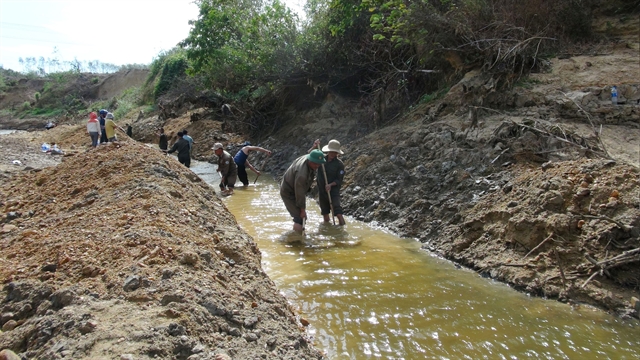 Society
Society

The central province of Quảng Trị is experiencing one of harshest summers in history. With a persistent dry wind and barely any rain, cracks have started appearing on local paddy fields.

|
| Local farmers dredge Vĩnh Phước River in Vĩnh Linh District to lead water to paddy fields. — VNA/VNS Photo Thanh Thuỷ |
QUẢNG TRỊ — The central province of Quảng Trị is experiencing one of harshest summers in history. With a persistent dry wind and barely any rain, cracks have started appearing on local paddy fields.
Looking at his lush crop, Trần Văn Tuyến, a farmer in Gio Thành Commune, Gio Linh District, said the drought might destroy the fruits of his labour.
“It will be a terrible waste. We are searching for water sources and hoping for rain in the next few days,” he said.
More than 800ha of peppercorn, 800ha of vegetables and 200ha of peanut have been damaged by the prolonged heat wave, according to the provincial department of agricultural and rural development.
Rice farmers have suffered the most severe losses, with 6,000ha of crops drying out, mostly in districts of Cam Lộ, Gio Linh and Vĩnh Linh – the province’s rice bowls.
The water shortage will prolong the summer-autumn crop by ten to fifteen days which may result in harvest failure.
The province’s 131 reservoirs with a total capacity of 423 million cubic metres of water provide water for more than 25,000ha of agricultural land, fish production and local homes. However, they have witnessed a dramatic drop in water levels.
Trúc Kinh, one of the largest lakes in Quảng Trị Province, which can contain up to 36 million cubic metres of water, is drying up, with an estimated 3 million cubic metres of water remaining.
Dozens of islets have appeared, scattered around the lake bed. And herds of cows can now head to these oases in search of grass.
A similar problem has occurred at other reservoirs of Kinh Môn, Ái Tử or Đá Mài.
Until early August, 11 heatwaves have drained crucial water sources for farming in the province.
Little rainfall, 50 to 60 per cent of last year’s average, along with the dry southeast wind has worsened the situation.
Meanwhile, salt intrusion has occurred in Bến Hải and Sa Lung, the two main rivers supplying water for paddy fields in Vĩnh Linh District.
Salinity evaluated at Nam Thạch Hãn dam flood gate on the province’s largest river of Thạch Hãn fluctuate between 3.5 and 19.7 per mille, the highest level since 2005.
To fight salt intrusion, local authorities had to close all flood drainage systems and build temporary dams.
At the same time, many temporary pumping stations have been set up to take water from ponds and canals to paddy fields in order to save dying crops.
Varieties of short-day rice including HN6, LDA1, KD, RVT and Thiên Ưu 8 are piloted on 22,500ha of agricultural land which help to save million cubic metre of water compared to long-day types, according to Hồ Xuân Hoè, deputy director of the provincial department of agriculture and rural development.
Many farmers have switched to other crops – coconut in Vĩnh Linh District or maize, peanut, green bean in districts of Hướng Hoá, Cam Lộ and Gio Linh – which require less water.
Local authorities also grant farmers subsidies to buy seeds at cheaper prices.
Some new models have shown positive signs.
Trần Mỹ, head of Lễ Môn Cooperative in Gio Phong Commune, Gio Linh District, said planting off-season watermelon help to reduce water, labour and earn greater profits – 10 to 12 times higher than rice, as watermelon could be harvested after two months.
The model will soon be duplicated in localities facing water shortages.
To better secure the water resources and efficient use of water for agriculture, Hà Sỹ Đồng, deputy head of Quảng Trị Province's People’s Committee, stressed upon the collaboration of irrigation companies with local authorities and farmers in distributing and saving water as well as mitigating salt intrusion.
The province set a plan to upgrade irrigation systems and cultivation schemes in response to extreme weather events. — VNS




